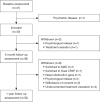Effect of switching from continuous to bilevel positive airway pressure on sleep quality in patients with obstructive sleep apnea: the prospective POP IN VAuto study
- PMID: 36910096
- PMCID: PMC9992565
- DOI: 10.21037/jtd-22-825
Effect of switching from continuous to bilevel positive airway pressure on sleep quality in patients with obstructive sleep apnea: the prospective POP IN VAuto study
Abstract
Background: Issues with tolerability and side effects can decrease continuous positive airway pressure (CPAP) device usage and the benefits of therapy. Different positive airway pressure (PAP) therapy modes providing expiratory pressure relief or using a different pressure during inspiration vs. expiration (bilevel PAP) may alleviate some of these issues. This multicenter, prospective study evaluated the effects of switching from CPAP to bilevel PAP (VAuto mode) on respiratory parameters, device usage, side effects and patient-reported outcomes in patients with obstructive sleep apnea (OSA).
Methods: Eligible OSA patients had started CPAP ≥3 months previously, had good compliance (mean 6.1±2.0 h/night) and well-controlled OSA [residual apnea-hypopnea index (AHI) 4.9±3.1/h] but had pressure tolerance issues or persistent side effects/discomfort. All were switched from CPAP to bilevel PAP (AirCurve 10 VAuto; ResMed). Effectiveness (residual AHI), sleep quality, daytime sleepiness, fatigue, therapy-related side effects, and patient satisfaction/preference were assessed after 3 months and 1 year.
Results: Forty patients were analyzed (68% male, age 64±11 years, body mass index 30.7±5.8 kg/m2). At 3 months and 1 year after switching to bilevel PAP, median [interquartile range] residual AHI was 4/h [2-5.3] and 3.7/h [1.8-5], respectively, and device usage was 7.0 [4.9-7.5] and 6.4 [4.4-7.3] h/night, respectively. Device switch was associated with significant reductions from baseline in expiratory PAP {from 12 [11-13] to 8 [7-9] cmH2O at 3 months (P<0.001) and 9 [8-12] cmH2O at 1 year (P=0.005)}, 95th percentile pressure {from 14 [12-14] to 10 [9-11] and 10 [8-11] cmH2O; P<0.001 and P=0.001, respectively} and leak {from 1 [0-6] to 0 [0-1] and 0 [0-2] L/min; P=0.049 and P=0.033, respectively}. The Pittsburgh Sleep Quality Index score decreased significantly from baseline to 3 and 6 months [7.2±4.0 to 5.0±3.2 (P=0.005) and 4.5±2.7 (P<0.001), respectively]. CPAP-related mouth dryness, choking sensation and aerophagia were significantly improved one year after switching to bilevel PAP. Bilevel PAP was preferred over CPAP by 90% of patients.
Conclusions: Switching to bilevel PAP had several benefits in patients struggling with CPAP, facilitating therapy acceptance and ongoing device usage.
Keywords: Positive airway pressure (PAP); daytime sleepiness; obstructive sleep apnea (OSA); patient preference; patient reported outcomes; sleep quality.
2023 Journal of Thoracic Disease. All rights reserved.
Conflict of interest statement
Conflicts of Interest: All authors have completed the ICMJE uniform disclosure form (available at https://jtd.amegroups.com/article/view/10.21037/jtd-22-825/coif). Alain Palot has received investigator fees for clinical trials funded by ResMed. SL has received investigator or co-investigator fees for clinical trials funded by Nyxoah, Oniris, ResMed, Orthosom, Isis Médical, Asten, has received consulting fees from Nyxoah, Bioprojet, travel grants from Oxyvie, Vitalaire, S2A Santé, UCB Pharma, Bioprojet and Jazz Pharmaceuticals, Speaker’s fees from Les Ateliers D’Arcachon, Cidelec, Philips, ResMed, Bioprojet, Jazz Pharmaceutical, and was an employee of Bioserenity from 2019 to 2021. Arnaud Prigent has received consulting fees from ResMed. AG, EA, and FL are employees of ResMed. The other authors have no conflicts of interest to declare.
Figures




References
LinkOut - more resources
Full Text Sources
Research Materials
